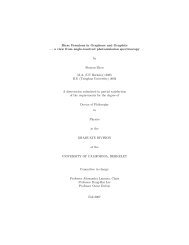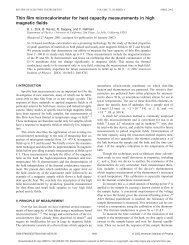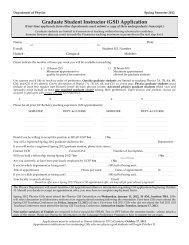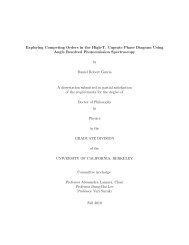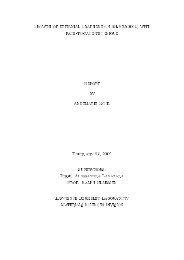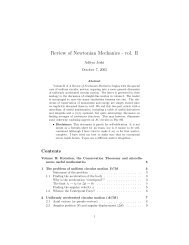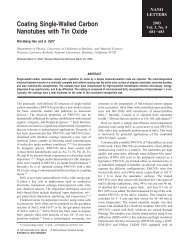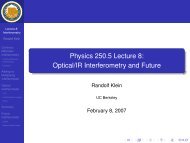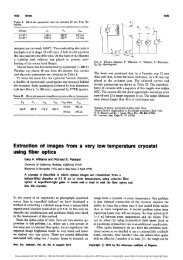Currentâphase relationship measurements in the flow of ... - Physics
Currentâphase relationship measurements in the flow of ... - Physics
Currentâphase relationship measurements in the flow of ... - Physics
Create successful ePaper yourself
Turn your PDF publications into a flip-book with our unique Google optimized e-Paper software.
Physica B 280 (2000) 130}131<br />
Current}phase <strong>relationship</strong> <strong>measurements</strong> <strong>in</strong> <strong>the</strong> #ow<br />
<strong>of</strong> super#uid He through a s<strong>in</strong>gle ori"ce<br />
Olivier Avenel*, Yury Mukharsky, ED ric Varoquaux<br />
CEA-DRECAM, Service de Physique de l+E! tat Condense& , Centre d+E! tudes de Saclay, 91191 Gif-sur-Yvette Cedex, France<br />
CNRS-Laboratoire de Physique des Solides, BaL t. 510, Universite& Paris-Sud, 91405 Orsay, France<br />
Abstract<br />
We report accurate <strong>measurements</strong> <strong>of</strong> <strong>the</strong> current-phase <strong>relationship</strong> <strong>in</strong> <strong>the</strong> #ow <strong>of</strong> super#uid He through a s<strong>in</strong>gle<br />
ori"ce. While ideal s<strong>in</strong>usoidal 2π-periodic Josephson behavior prevails close to ¹ <br />
, <strong>in</strong>creas<strong>in</strong>gly strong π-periodic<br />
admixture is usually observed at lower temperatures. 2000 Elsevier Science B.V. All rights reserved.<br />
Keywords: Current}phase <strong>relationship</strong>; He super#uid; Josephson e!ect<br />
The m<strong>in</strong>iature Helmholtz resonator [1] that we used<br />
earlier to demonstrate Josephson e!ects <strong>in</strong> super-<br />
#uid He [2] and to measure <strong>the</strong> Earth's rotation <strong>in</strong><br />
super#uid He [3] is now be<strong>in</strong>g used to make accurate<br />
<strong>measurements</strong> <strong>of</strong> <strong>the</strong> mass current J(θ) <strong>of</strong> super#uid<br />
He-B through a s<strong>in</strong>gle ori"ce as a function <strong>of</strong> <strong>the</strong> phase<br />
di!erence θ across it. In <strong>the</strong>se new experiments <strong>the</strong> ori"ce<br />
is a 0.182.6 μm slit <strong>in</strong> a 0.1 μm thick silicon nitride<br />
membrane and <strong>the</strong> parallel path is a 5.9 cm rotation<br />
pick-up loop.<br />
The slope <strong>of</strong> <strong>the</strong> current}phase <strong>relationship</strong> is obta<strong>in</strong>ed<br />
by record<strong>in</strong>g <strong>the</strong> small amplitude free oscillation resonance<br />
frequency ω,<br />
dJ/dθ"ω/ω <br />
!1. (1)<br />
ω <br />
, <strong>the</strong> Helmholtz frequency <strong>of</strong> <strong>the</strong> parallel path alone, is<br />
measured as <strong>the</strong> large signal resonance frequency.<br />
This device is a very sensitive rotation sensor [4], and<br />
coupl<strong>in</strong>g to <strong>the</strong> Earth's rotation is used to vary <strong>the</strong> phase<br />
bias θ across <strong>the</strong> ori"ce. In <strong>the</strong> laboratory frame, <strong>the</strong><br />
rotation <strong>of</strong> <strong>the</strong> Earth <strong>in</strong>duces a circulation κ <br />
"2 Ω <br />
) A<br />
<strong>in</strong> <strong>the</strong> pick-up loop <strong>of</strong> oriented area A. The correspond<strong>in</strong>g<br />
phase di!erence along <strong>the</strong> loop is θ <br />
"2πκ <br />
/κ <br />
, κ <br />
be<strong>in</strong>g <strong>the</strong> quantum <strong>of</strong> circulation. The equilibrium phase<br />
* Correspond<strong>in</strong>g author.<br />
E-mail address: avenel@drecam.saclay.cea.fr (O. Avenel)<br />
di!erence θ across <strong>the</strong> ori"ce satis"es <strong>the</strong> load l<strong>in</strong>e<br />
equation<br />
J(θ)"!(θ!θ <br />
), (2)<br />
which expresses <strong>the</strong> fact that <strong>the</strong> current through <strong>the</strong><br />
ori"ce balances <strong>the</strong> current through <strong>the</strong> parallel path<br />
when <strong>the</strong> membrane is at rest. The curves J(θ) are obta<strong>in</strong>ed<br />
by <strong>in</strong>tegration <strong>of</strong> Eqs. (1) and (2) us<strong>in</strong>g resonance<br />
frequency <strong>measurements</strong> as a function <strong>of</strong> cryostat<br />
orientation.<br />
Di!erent shapes are usually observed at <strong>the</strong> same temperature<br />
<strong>in</strong> each cool-down through <strong>the</strong> transition temperature<br />
¹ <br />
, as shown <strong>in</strong> Fig. 1a.<br />
But J(θ) is usually robustly "xed <strong>in</strong> each run and<br />
<strong>the</strong> general trend is to go from 2π periodicity to π<br />
periodicity when <strong>the</strong> temperature is lowered, Fig. 1b,<br />
although on one occasion no π periodicity was observed<br />
at <strong>the</strong> lowest ¹. The curves <strong>in</strong> Fig. 1b are probably not<br />
hysteretic, dissipative phase slips cannot be resolved but,<br />
due to rotational noise, <strong>the</strong> small signal resonance is<br />
di$cult to track when J(θ) is nearly parallel to <strong>the</strong> load<br />
l<strong>in</strong>e.<br />
Hysteretic behavior prevails at higher pressure, as represented<br />
<strong>in</strong> Fig. 1c. At low temperatures up to three<br />
well-de"ned resonances can be tracked at some cryostat<br />
orientations, and phase slips take place. Switch<strong>in</strong>g from<br />
one branch to ano<strong>the</strong>r is done by apply<strong>in</strong>g pulses to <strong>the</strong><br />
membrane.<br />
0921-4526/00/$ - see front matter 2000 Elsevier Science B.V. All rights reserved.<br />
PII: S 0 9 2 1 - 4 5 2 6 ( 9 9 ) 0 1 5 1 7 - 3
O. Avenel et al. / Physica B 280 (2000) 130}131 131<br />
existence <strong>of</strong> π/2 states <strong>in</strong> such an array when J(θ) has<br />
π periodicity and is hysteretic [6].<br />
We conjecture that <strong>the</strong> di!erent J(θ) obta<strong>in</strong>ed <strong>in</strong> successive<br />
cool-downs come from di!erent textural states,<br />
established when cool<strong>in</strong>g through ¹ <br />
. Indeed, two di!erent<br />
current-phase <strong>relationship</strong>s have been predicted <strong>in</strong><br />
He-B for parallel and anti-parallel n vectors on each<br />
side <strong>of</strong> <strong>the</strong> ori"ce [7]. No calculation has been done for<br />
arbitrary orientations which may well be met <strong>in</strong> <strong>the</strong><br />
present resonator with submillimeter size cyl<strong>in</strong>drical volumes<br />
on each side. Our earlier <strong>measurements</strong> [2] did not<br />
reveal departures from 2π periodicity, at least down to<br />
0.7¹ <br />
. The #exible membrane used <strong>the</strong>n was coated with<br />
Al through which <strong>the</strong> magnetic "eld <strong>of</strong> <strong>the</strong> displacement<br />
sensor could leak [1]. The present coat<strong>in</strong>g with Pb is less<br />
permeable to "eld. Also, <strong>the</strong> support<strong>in</strong>g material <strong>of</strong> <strong>the</strong><br />
ori"ce has been changed from ferromagnetic Ni to <strong>in</strong>ert<br />
Si <br />
N <br />
. No orientation <strong>of</strong> n is really favored <strong>in</strong> <strong>the</strong> present<br />
set-up, which probably expla<strong>in</strong>s <strong>the</strong> di!erent determ<strong>in</strong>ations<br />
<strong>of</strong> J(θ) seen <strong>in</strong> Fig. 1.<br />
Note added <strong>in</strong> pro<strong>of</strong><br />
A recent calculation <strong>in</strong>deed predicts di!erent current}<br />
phase <strong>relationship</strong>s for di!erent orientations <strong>of</strong> <strong>the</strong> n vector<br />
on each side <strong>of</strong> a s<strong>in</strong>gle p<strong>in</strong>hole [8]. See also Refs.<br />
[9,10].<br />
References<br />
Fig. 1. Current}phase <strong>relationship</strong>s. (a) 0.2 bar, 4 cool-downs at<br />
&0.845¹ <br />
. (b) 0.2 bar, at 0.889, 0.837, 0.677 and 0.469¹ <br />
;<br />
vertical scale multiplied by 2 for <strong>the</strong> two dotted l<strong>in</strong>es at low ¹.<br />
(c) 10 bars, same run at 0.968, 0.945, 0.905 and 0.756¹ <br />
. The<br />
straight l<strong>in</strong>es are <strong>the</strong> load l<strong>in</strong>es, Eq. (2), shifted horizontally by<br />
reorient<strong>in</strong>g <strong>the</strong> cryostat.<br />
A positive slope <strong>of</strong> J(θ) around π can expla<strong>in</strong> <strong>the</strong><br />
observation <strong>of</strong> π states <strong>in</strong> an array <strong>of</strong> holes [5], even<br />
<strong>in</strong> non-hysteretic regimes. We would <strong>the</strong>n predict <strong>the</strong><br />
[1] O. Avenel, E. Varoquaux, <strong>in</strong>: G. Klipp<strong>in</strong>g, I. Klipp<strong>in</strong>g<br />
(Eds.), Proceed<strong>in</strong>gs <strong>of</strong> <strong>the</strong> ICEC11, Berl<strong>in</strong>, Germany, Butterworths,<br />
1986, p. 587.<br />
[2] O. Avenel, E. Varoquaux, Jpn. J. Appl. Phys. (Suppl.) 26 (3)<br />
(1987) 1798.<br />
[3] O. Avenel, E. Varoquaux, Czech. J. Phys. 46 (S6) (1996)<br />
3319.<br />
[4] Y. Mukharsky, O. Avenel, E. Varoquaux, Physica B, <strong>the</strong>se<br />
proceed<strong>in</strong>gs.<br />
[5] S. Backhaus et al., Nature 392 (1998) 687.<br />
[6] O. Avenel et al., Nature 397 (1999) 484 and 662.<br />
[7] E.V. Thuneberg, Europhys. Lett. 7 (1988) 441.<br />
[8] S.-K. Yip, Phys. Rev. Lett. 83 (1999) 3864.<br />
[9] J.K. Viljas, E.V. Thuneberg, Phys. Rev. Lett. 83 (1999)<br />
3868.<br />
[10] A. Marchenkov et al., Phys. Rev. Lett. 83 (1999) 3860.





